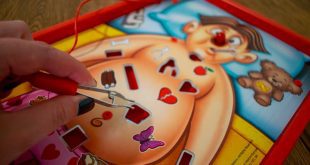 Do the exercises every day for back pain won’t bother you.
Do the exercises every day for back pain won’t bother you.
Aching back? Feel discomfort? Yoga will help. These asanas and ligaments, and relieve tired spine.
Especially recommended to those who lead a sedentary lifestyle, advises the instructor of Hatha yoga, psychologist Elena Ustinova.
PADMASANA (THE LOTUS POSITION)
The Lotus position — what is needed for the prevention of back pain. It strengthens the coccygeal and lumbar regions of the spine, corrects posture, improves blood flow to the lower abdomen, improve metabolism. In addition, the Lotus pose helps to cope with stress and relieve tension.
HOW TO DO:
From a seated position bend the right leg at the knee and put right foot on left thigh, heel close to the navel. Bend the left leg at the knee and laid it on the right thigh, the heel palm to the navel. Expand the soles of the feet to the ceiling. Lengthen the spine, relax the shoulders and put his hands on his knees.
In this position, try to relax and stay for 60 seconds. Then repeat the pose on the other side (starting with the left foot instead of the right).
PRASARITA OF PADOTTANASANA (POSTURE STRETCHED FOOT)
Eliminates back pain, perfectly strengthens and tones the spine and organs of the thoracic and abdominal cavity. In addition, this asana is working on hamstring, back and inside of the legs, improves the mobility of hip joints, normalizes the bowels.
HOW TO DO:
Feet away from each other on a width approximately equal to the length of the leg. The outer edge of the stop parallel to each other. Hands put on the belt. On the inhale pulls the kneecap, the top of the head reach up, lengthening the spine. Exhaling, bend over and drop your palms on the floor on one line with the feet. On the inhale bend at the waist and raise the head up. On the exhale, bend your elbows and drop the top on the floor.
Stay in this position for 30 seconds. Ensure that the body weight fell on his feet. With an inhalation, open the head from the floor, straighten your elbows and slowly climb up.
UTTHITA OF PARSVAKONASANA (POSTURE ELONGATED SIDE ANGLE)
Eliminates pain in the lower back, stretches the spine and chest. This asana stimulates the abdominal organs, removes constipation and increases endurance.
HOW TO DO:
The distance between the feet is approximately equal to the length of the feet, hands at shoulder level, palms directed at the floor.
With exhalation turn the right foot 90° to the right, left turning a little inwards. Bend right knee to a right angle, tightens the kneecap of the left leg. Put the right palm with the outer edge of the right foot and stretch left hand upwards. The gaze is directed behind the finger and hand. Lengthen the spine, stretch the ribs and vertebrae. Body from left ankle to left wrist strained like an arrow.
Stay in this position for 30 seconds. Inhaling severing the right hand from the floor and climb up. On the exhale, turn the left foot to the left and repeat Parsvakonasana on the other side.
UPAVISTA OF KONASANA (POSTURE ANGLE IN THE SITTING POSITION)
Upavista of Konasana actually refers to asanas for opening of the pelvis. But how well it works on the spine! Pull it, strengthens the back, removes the clamps and prevents the development of intervertebral hernias. In addition, the implementation of Konasana stimulates the activity of the ovaries and calms the nervous system.
HOW TO DO:
From sitting on the floor with legs extended alternately dilute legs as wide as possible. The legs are straight, the rear surface of the thighs and shins pressed to the floor, socks are stretched themselves.
Grab yourself for the big toes and on the inhale straighten the spine, slightly bending at the waist and opening the chest. The gaze is directed upwards. On the exhale, lean elongated body and laid down on the floor, forehead, nose or chin. Seek to lower the belly and the chest as low as possible. Remain in this position for 30-60 seconds. Exhaling, slowly raise your torso up and connect the legs together.
USTRASANA (CAMEL POSE)
Lengthens and tones the spine, helping to get rid of slouching. Camel pose develops balance and generates confidence. Ustrasana is also recommended to perform hypotension to normalize blood pressure.
HOW TO DO:
Kneel, which have a shoulder width of the pelvis. Feet are on the floor, toes directed backwards.
On inspiration drawn over the top of the head up, lengthening the spine. Lean back and put your palms on the bottoms of the feet or heels. Exhaling, bend in the chest, taking his head back.
Finding the maximum possible at the moment deflection point, stay in it for 30 seconds. Held the asana due to the strength of the legs. On the exhale, slowly unbend, returning to the starting position.
PURVOTTANASANA (POSTURE INVERTED STRAP)
Relieves back pain and is great for opening the chest and the formation of correct posture. This pose strengthens the wrists and ankles, ensure good mobility of the shoulder joints. Asana is suitable for beginners.
HOW TO DO:
From a sitting position with straight legs have the palm behind, fingers directed forward toward the legs (or Purvottanasana on the fingers directed backwards).
On the inhale, pushing with the palms, lift the pelvis off the floor and climb as high up as possible. Stomach. Straighten legs, seeking the bottom of her feet to stand on the floor. Hands from wrists to shoulders perpendicular to the floor, and the body from the shoulders to the pelvis parallel to it.
Craning his neck, attach the head as far back as possible. Stay in the pose for 20-30 seconds.
Exhaling, lower the pelvis on the floor and relax.
SARVANGASANA (CANDLE POSTURE)
One of the most important yoga asanas that benefit the entire body. Its implementation enhances flexibility and nerve conduction in the cervical spine, relieves pain in the neck. Sarvangasana calms headaches and colds, improves blood flow to the thyroid and parathyroid glands, stimulating their work, has a powerful rejuvenating effect.
HOW TO DO:
Starting position: lying down, arms stretched along the body, palms face down.
On the exhale lift your pelvis off the floor, point the knee to the face. Simultaneously bend your elbows and put your palms on the back, guiding his fingers to the side of the pelvis. Inhaling his knees to the ceiling, lowering the heel to the buttocks. Then straighten your knees, directing your toes to the ceiling. Neck, nape, shoulders and forearms are on the floor, chest touches the chin.
Stay in this position from 30 seconds to 1 minute. Exhaling, bend your knees and slowly falls to the floor.
CHAKRASANA OR URDHVA DHANURASANA (BRIDGE)
To the long spine healthy and flexible, and back pain are not tortured. In addition, this asana improves eyesight, levels hormones and calms the nervous system. Chakrasana improves blood flow to the brain, increasing the level of intelligence and speed of thinking.
HOW TO DO:
From the supine position put the hands under the shoulders, fingers facing feet. Bend your knees, heels rested in the buttocks.
On the exhale, raise the trunk up against the crown to the floor. With the next exhale lift the body and head from the floor, maximum rotting back. Straighten your elbows and extend your thighs up. Remain in this position for 20-30 seconds.
Then try to lift the heel from the floor and transfer the body weight on the toes. Stay in this position for another 5 seconds. On the exhale, bend the knees and elbows, falls to the floor.
If you from time to time suffer from back pain, will regularly perform these 8 asanas. But what if my back hurts right now? In this case, you will approach the first four exercises. Importantly, by performing these asanas, to listen to yourself and avoid discomfort.








